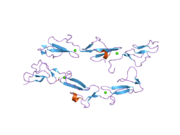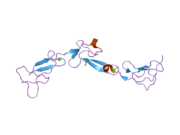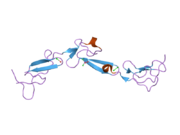EMR2
| ADGRE2 | |||
|---|---|---|---|
Gene ontology | |||
| Molecular function | |||
| Cellular component | |||
| Biological process | |||
| Sources:Amigo / QuickGO | |||
Ensembl |
| ||||||||
|---|---|---|---|---|---|---|---|---|---|
| UniProt |
| ||||||||
| RefSeq (mRNA) |
|
| |||||||
| RefSeq (protein) |
| ||||||||
| Location (UCSC) | Chr 19: 14.73 – 14.78 Mb | n/a | |||||||
| PubMed search | [2] | n/a | |||||||
| View/Edit Human | |||
EGF-like module-containing mucin-like hormone receptor-like 2 also known as CD312 (
Adhesion GPCRs are characterized by an extended extracellular region often possessing N-terminal protein modules that is linked to a TM7 region via a domain known as the GPCR-Autoproteolysis INducing (GAIN) domain.[6]EMR2 is expressed by monocytes/macrophages, dendritic cells and all types of granulocytes.[7] In the case of EMR2 the N-terminal domains consist of alternatively spliced epidermal growth factor-like (EGF-like) domains. EMR2 is closely related to CD97 with 97% amino-acid identity in the EGF-like domains. The N-terminal fragment (NTF) of EMR2 presents 2-5 EGF-like domains in human.[8] Mice lack the Emr2 gene.[9] This gene is closely linked to the gene encoding EGF-like molecule containing mucin-like hormone receptor 3 EMR3 on chromosome 19.
Ligand
Like the related
Signaling
Inositol phosphate (IP3) accumulation assays in overexpressing HEK293 cells have demonstrated coupling of EMR2 to Gα15.[12] EGF-like module-containing mucin-like hormone receptor-like 2 (EMR2) is an adhesion GPCR that undergoes GPS autoproteolysis before being trafficked to the plasma membrane.[13] Further, distribution, translocation, co-localization of the N-terminal fragment (NTF) and N-terminal fragment (CTF) of EMR2 within lipid rafts may affect cell signaling.[14] Mutations in the GPS have shown that EMR2 does not need to undergo autoproteolysis to be trafficked, but loses function. EMR2 has been shown to be necessary for in vitro cell migration. Upon cleavage the N-terminus has been shown to associate with the 7TM, but to also dissociate, giving two possible functions. When the N-terminus dissociates it can be found in lipid rafts. Additionally, the cleaved EMR2 protein 7TM has been found to associate with EMR4 N-terminus.
Function
The expression of EMR2 and CD97 on activated lymphocytes and myeloid cells promotes binding with their ligand chondroitin sulfate B on peripheral B cells, indicating a role in leukocyte interaction.[15] The interaction between EMR2 and chondroitin sulfate B in inflamed rheumatoid synovial tissue suggests a role of the receptors in the recruitment and retention of leukocytes in synovium of arthritis patients.[16] Upon neutrophil activation, EMR2 rapidly moves to membrane ruffles and the leading edge of the cell. Additionally, ligation of EMR2 by antibody promotes neutrophil and macrophage effector functions suggesting a role in potentiating inflammatory responses.[14][17]
Clinical significance
EMR2 is rarely expressed by tumor cell lines and tumors, but has been found on breast and colorectal adenocarcinoma.[18][19] In breast cancer, robust expression and different distribution of EMR2 is inversely correlated with survival.[20] Gain of function mutations within the GAIN domain of EMR2 of certain patient cohorts were shown to result in excessive degranulation by mast cells resulting in vibratory
See also
References
- ^ a b c GRCh38: Ensembl release 89: ENSG00000127507 – Ensembl, May 2017
- ^ "Human PubMed Reference:". National Center for Biotechnology Information, U.S. National Library of Medicine.
- PMID 25713288.
- ISBN 978-1-4419-7912-4.
- S2CID 6958640.
- PMID 22333914.
- PMID 10903844.
- S2CID 29257475.
- S2CID 16254868.
- PMID 12829604.
- S2CID 16582952.
- S2CID 3020230.
- PMID 15150276.
- ^ PMID 22310662.
- S2CID 15589445.
- PMID 15693006.
- S2CID 16235723.
- S2CID 31812716.
- PMID 12428789.
- PMID 21174063.
- PMID 26841242.



